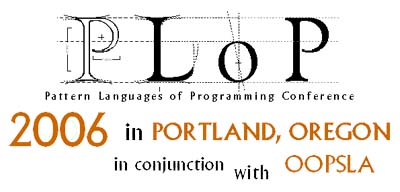|
home > plop > 2006 > Papers > Notes > 5-notes.php

PLoP 2006
Shepherded Papers
Notes on Paper 5: REJECTED
I do NOT recommend accepting the research paper "Latent Binding of Pattern
Specialization" to be presented/workshoped at the conference. This summary
is based on the version submitted on July 30th.
Summary of the paper:
The paper claims that design patterns only handle the reuse of design
without any concern for reuse of code. Therefore, every time when a
developer wants to use a design pattern, she must pass through the
"tedious" hurdle of implementing the design pattern into her codebase. As
a solution, the authors propose a separation of concerns between patterns
and their particular binding to a specific code base. In the design phase,
designers can use some skeletons of patterns, without referring to the
concrete classes that will eventually be the contributors of the patterns.
In the implementation phase, developers can reuse those pattern skeletons
(provided as a library of reusable pattern skeletons) and bind the
concrete codebase classes to these design skeletons.
Problems/Flaws:
Besides the writing problems, there is something at the conceptual level
that I could not agree with. First, I have used patterns many times as a
developer. It never felt to me that using patterns was a burden because I
had to apply them to my particular context. I had a hard time explaining
the authors that patterns are not about code reuse, but about reuse of
ideas. If they are looking for both kinds of reuse, frameworks provide
reuse of both code and ideas. Second, any solution that is not
considerably simpler or requires considerable less time than implementing
the "classic" design pattern, is not worth using.
Improvement during shepherding:
The paper originally started as a "pattern". I strongly suggested that
they drop the misnomer "pattern" (since they did not present a pattern)
and instead write a research paper on patterns. The authors followed my
advice. However, there are many other times during the three iterations
that we went through, that the authors seemed to pay no attention to my
lengthy and detailed suggestions for improvement. I felt many times that I
literally wasted valuable hours, since the authors had a hard time
incorporating my feedback. After explicitly complaining myself to the
authors, they seem to have incorporated some of my advice on the latest
version (July 30th).
Relevance to the research literature on patterns:
The writing is weak compared to the standards of a research paper:
- Introduction. The paper is poorly motivated. The reader is not convinced
that the problem they try to solve is real/important.
- Related Work. Although the paper cites 12 related work, the treatment of
the related work is poor too. The related work should map the research
territory for a new reader in this research field. This paper fails to do
so.
- Evaluation. There is not a hint about how would one evaluate their claim
that the proposed solution could reduce the complexity and time required
to implement design patterns. In my opinion, the extra work that a
developer needs to bind the concrete classes to the library pattern
skeletons is no simpler or no quicker than implementing the classical
pattern. It looks like the authors are not even concerned with evaluation.
- Research contribution. I could not see anything that is researchy/hard
in their proposed solution. This paper leaves a hard-core researcher
asking himself why did he wasted time reading the material. <<<<<<<<<<<
best,
Danny
To keep up on the latest
PLoP information, subscribe to:
plop-announce-subscribe@hillside.net.
|